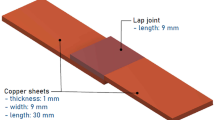Abstract
Modern customer durable products are subjected to severe operating conditions and require a variety of quality electrical contacts for improved performance and service life in diverse applications. Over a few decades, ultrasonic metal welding process has evolved as a suitable manufacturing technique for large-scale rapid manufacturing of such electrical contacts. In this investigation, the welding parameters such as clamping pressure, amplitude of vibration of the sonotrode, weld time and the part dimensions such as diameter of wire and thickness of the sheet are considered for joining electrical contacts comprising of copper wire and sheet. Experiments are conducted according to the response surface method with two replications to obtain the response of T-peel strength of the joint. The effect of process parameters on the strength of joint is vividly investigated, and a process characteristic map is developed for improvement of the process to produce defect-free electrical contacts. The lower level of clamping pressure (2 bar), medium level of amplitude of vibration of the sonotrode (47.5 μm), weld time (2.5 s), diameter of the wire (1.2 mm) and thickness of the sheet (0.2 m) are found to be effective to produce electrical contacts with maximum strength of the joint of more than 220 N. The results from experiments are utilized to develop a mathematical model for prediction of strength of the joint. The results predicted by using the model are in good agreement with results from experiments.

















Similar content being viewed by others
References
Kumar JP (2018) Effect of temperature distribution in ultrasonically welded joints of copper wire and sheet used for electrical contacts. Materials 11:1–13
Braunovic M, Myshkin NK, Konchits VV (2006) Electrical contacts: fundamentals, applications and technology, 1st edition. CRC press. New York, pp 149–172
Chamberlain A, Larsson H, Vasquez D, Schouri S, Myrsell E, Wallin S (2009) Welding methods for electrical connections in battery systems. Dissertation
Long Y, Twiefel J, Wallaschek J (2107) A review on the mechanisms of ultrasonic wedge-wedge bonding. J Mater Process Technol 245:241–258
Kumar S, Wu CS, Padhy GK, Ding W (2017) Application of ultrasonic vibrations in welding and metal processing: a status review. J Manuf Process 26:295–322
Ensminger D, Bond LJ (2011) Ultrasonics: fundamentals, technologies, and applications, 3rd ed. CRC Press, New York, pp 11–23
sanga B, wattal R, Nagesh DS (2018) Mechanism of joint formation and characteristics of interface in ultrasonic welding: literature review. Period Eng Nat Sci 6:107–119
Das A, Masters I, Williams D (2019) Process robustness and strength analysis of multi-layered dissimilar joints using ultrasonic metal welding. Int J Adv Manuf Technol 101:881–900
Raja S, Balaji N (2018) Prediction of weld strength of ultrasonic metal welding of copper wire–Al8011 sheet. Int J Pure Appl Math 119:2217–2224
Das A, Li D, Williams D (2019) Weldability and shear strength feasibility study for automotive electric vehicle battery tab interconnections. J Braz Soc Mech Sci Eng 54:1–14
Iwamoto C, Yamauchi K, Motomura K, Hashimoto Y, Hamada K (2019) Microstructure of joint between stranded wire and substrate welded by ultrasonic welding. Appl Sci 9:1–10
Tsujino J, Ihara S, Harada Y, Kasahara K, Sakamaki N (2004) Characteristics of coated copper wire specimens using high frequency ultrasonic complex vibration welding equipments. Ultrasonics 42:121–124
Tian Y, Wang C, Lum I, Mayer M, Jung JP, Zhou Y (2008) Investigation of ultrasonic copper wire wedge bonding on Au/Ni plated Cu substrates at ambient temperature. J Mater Process Technol 208:179–186
Myers RH, Montgomery DC, Anderson-Cook CM (2016) Response surface methodology: process and product optimization using designed experiments. Wiley
Elangovan S, Anand K, Prakasan K (2012) Parametric optimization of ultrasonic metal welding using response surface methodology and genetic algorithm. Int J Manuf Technol 63(5–8):561–572
Elangovan S, Venkateswaran S, Prakasan K (2012) Experimental investigations on optimization of ultrasonic welding parameters for copper to brass joints using response surface method and genetic algorithm. Int J of Adv Eng Rese Stud 1:55–64
ASTM International Codes (2005) Standard test method for apparent shear strength of single-lap-joint adhesively bonded metal specimens by tension loading (metal-to-metal). Designation: D 1002 – 05, 1:52–55
Pradeep Kumar J, Prakasan K (2018) Acoustic horn design for joining metallic wire with flat metallic sheet by ultrasonic vibrations. J Vibroengineering 20(7):2758–2770
Pradeep Kumar J, Arun Kumar MS, Gowsalya Devi N, Naveen Kumar M, Pavith Raja SM (2018) Numerical study on stress distribution in ultrasonically welded electrical contacts used in automotives. Int J Veh Struct Syst 10:287–290
Acknowledgements
The author is so thankful to Dr. K. Prakasan Principal of PSG College of Technology, Coimbatore for providing the essential guidance and facility to carry out this work.
Funding
This research was funded by University Grants Commission, New Delhi, under Major Research Project Scheme (F.No.42-876/2013(SR)).
Author information
Authors and Affiliations
Corresponding author
Additional information
Publisher’s note
Springer Nature remains neutral with regard to jurisdictional claims in published maps and institutional affiliations.
Recommended for publication by Commission III - Resistance Welding, Solid State Welding, and Allied Joining Process
Rights and permissions
About this article
Cite this article
Kumar, J.P. Effect of process parameter characteristics on joint strength during ultrasonic metal welding of electrical contacts. Weld World 64, 73–82 (2020). https://doi.org/10.1007/s40194-019-00820-2
Received:
Accepted:
Published:
Issue Date:
DOI: https://doi.org/10.1007/s40194-019-00820-2




